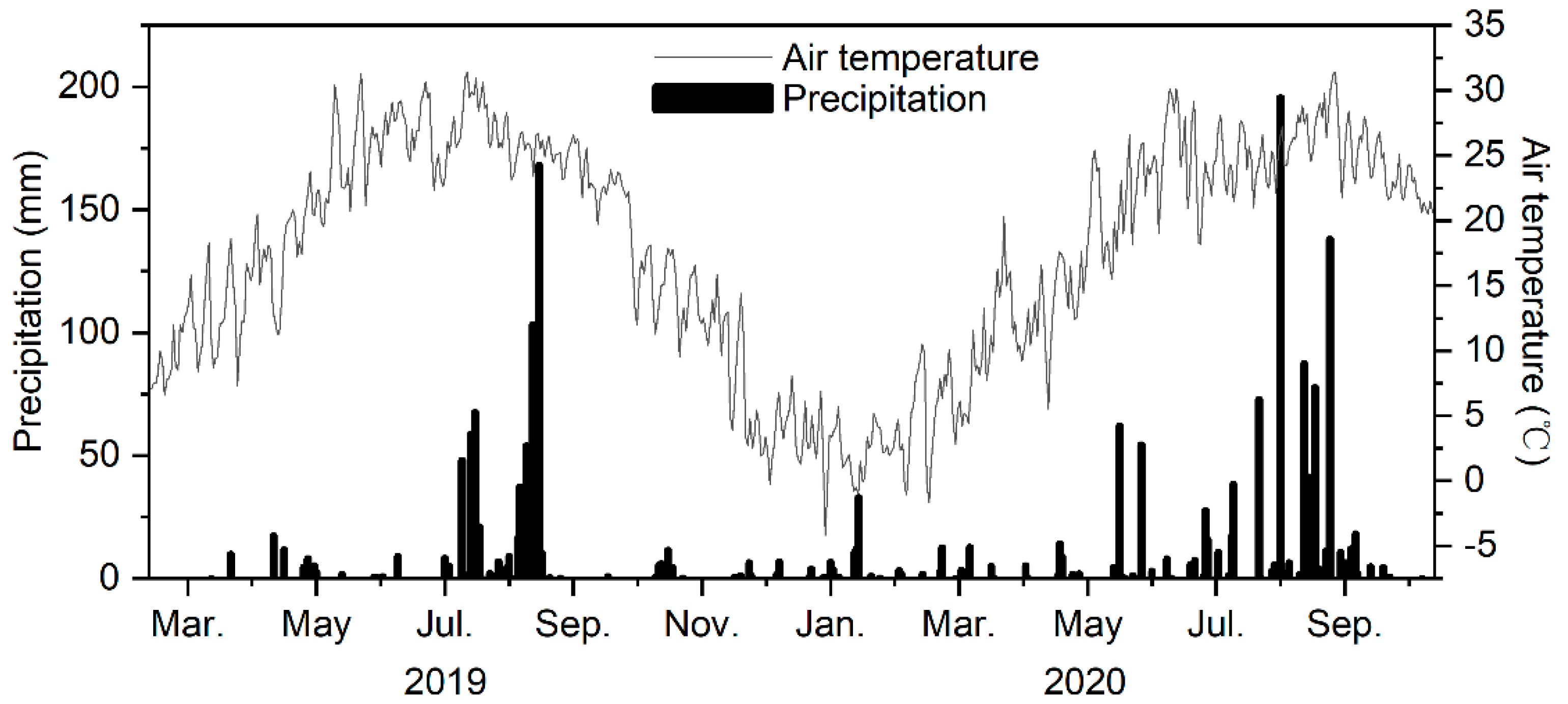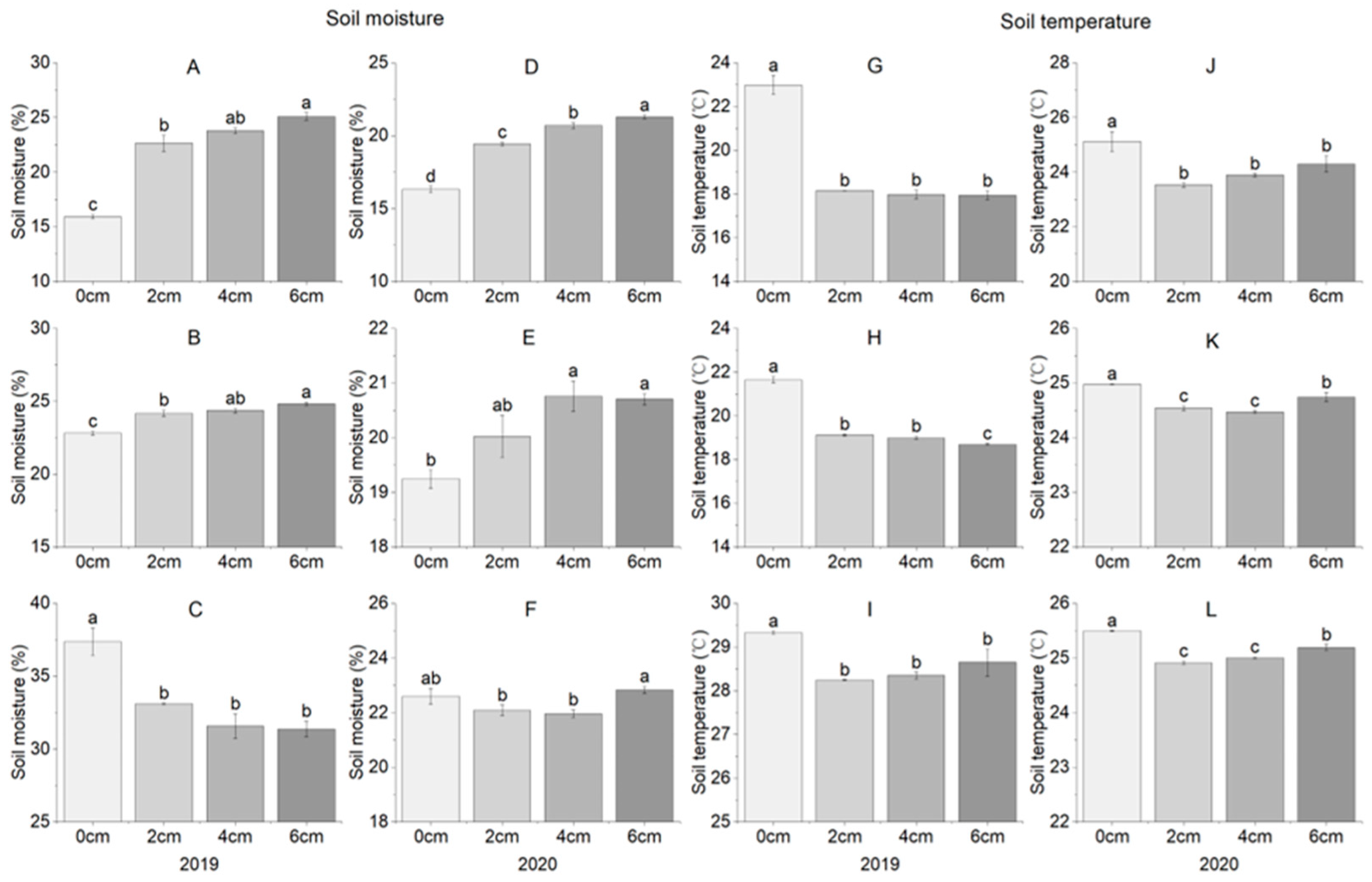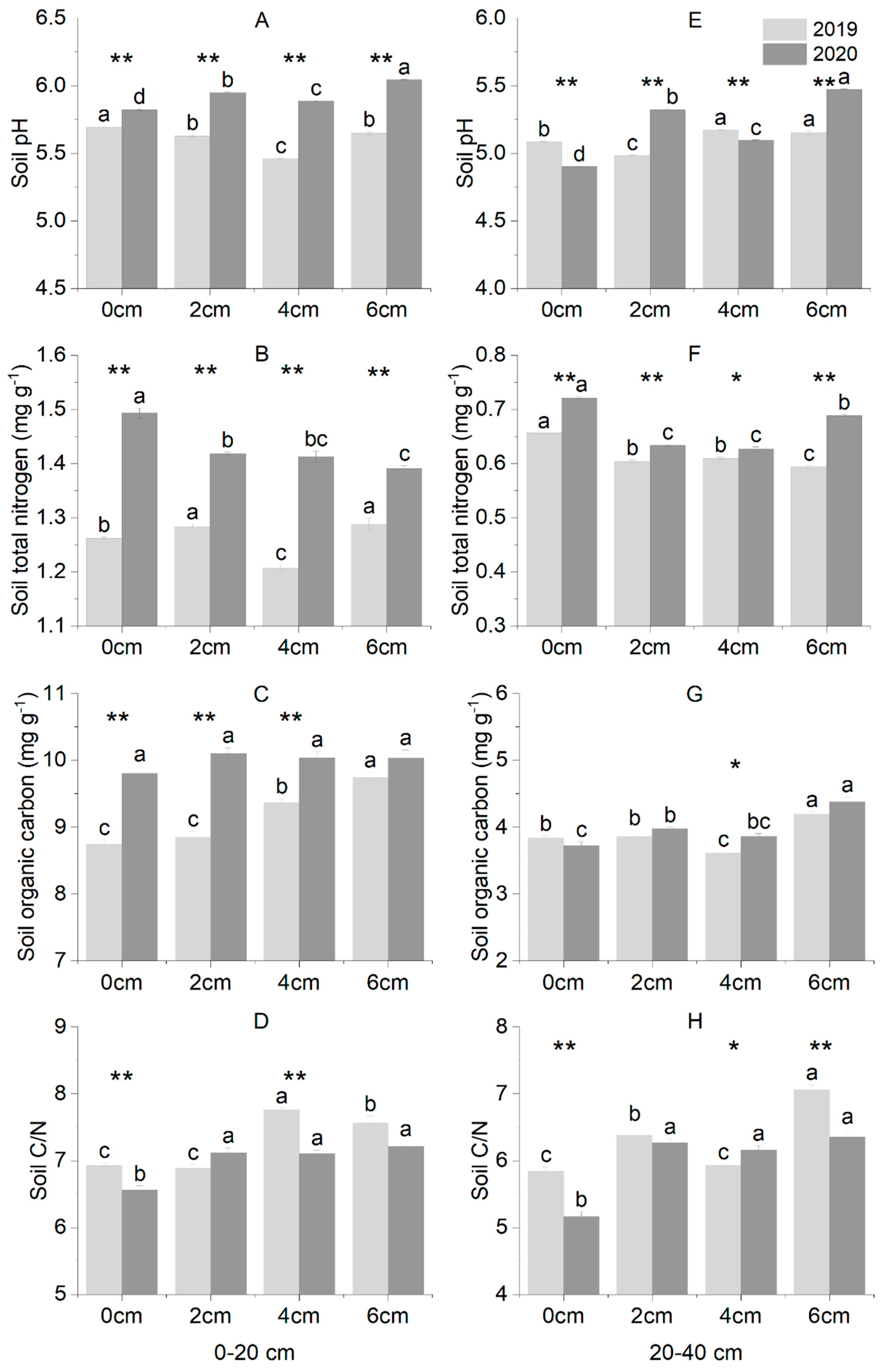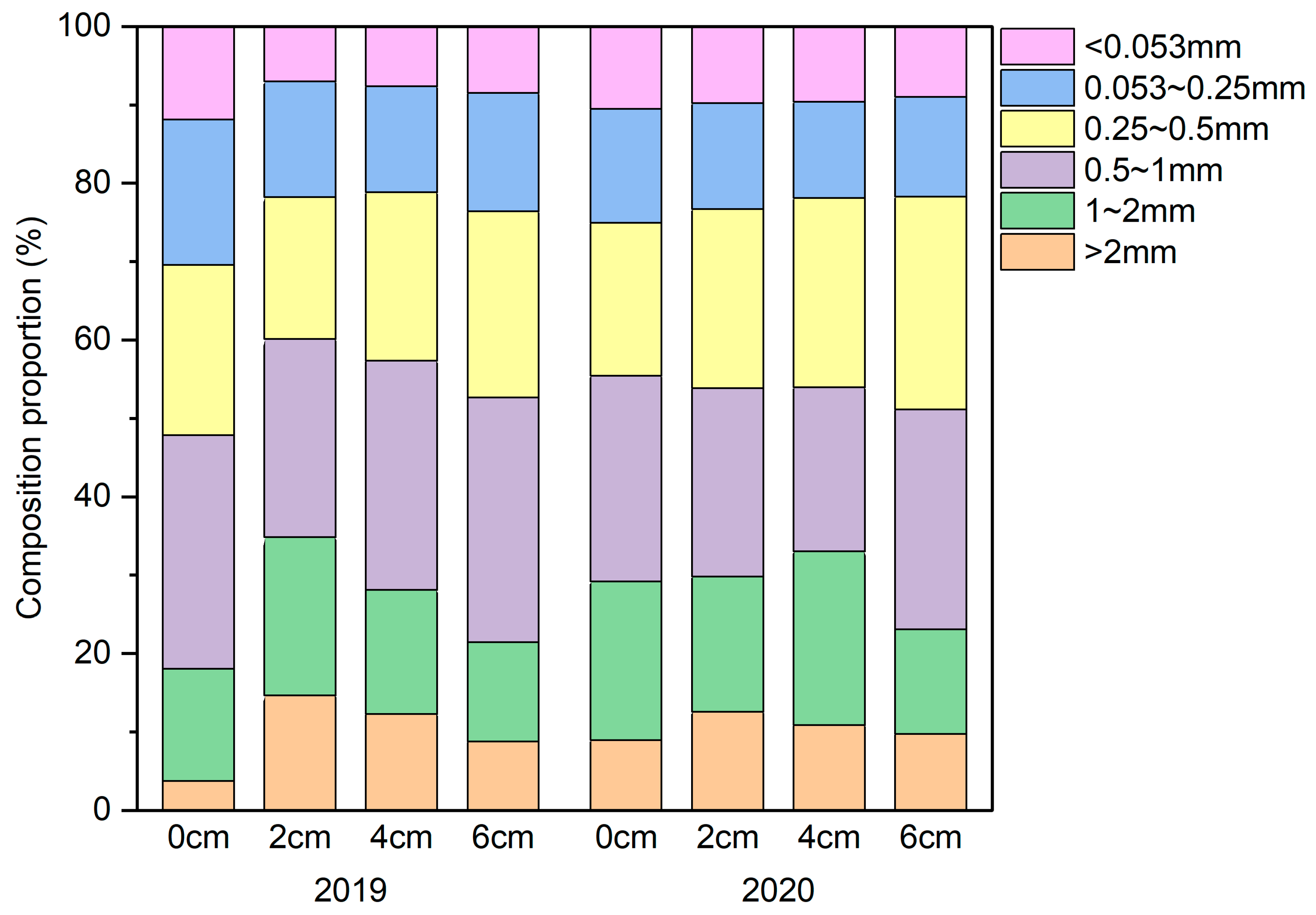Effects of Straw Mulching Thickness on the Soil Health in a Temperate Organic Vineyard
Abstract
:1. Introduction
2. Materials and Methods
2.1. Study Area
2.2. Experimental Design
2.3. Soil Sampling and Measurements
2.3.1. Soil Properties
2.3.2. Soil Aggregate
2.3.3. Soil Bulk Density
2.4. Statistical Analyses
3. Results
3.1. Soil Temperature and Moisture
3.2. Soil Properties
3.3. Soil Aggregate
3.4. Soil Bulk Density
3.5. Principal Component Analysis of Environmental Factors
4. Discussion
5. Conclusions
Author Contributions
Funding
Institutional Review Board Statement
Data Availability Statement
Acknowledgments
Conflicts of Interest
References
- Winter, S.; Bauer, T.; Strauss, P.; Kratschmer, S.; Paredes, D.; Popescu, D.; Landa, B.; Guzman, G.; Gomez, J.A.; Guernion, M.; et al. Effects of vegetation management intensity on biodiversity and ecosystem services in vineyards: A meta-analysis. J. Appl. Ecol. 2018, 55, 2484–2495. [Google Scholar] [CrossRef] [Green Version]
- Meemken, E.-M.; Qaim, M. Organic Agriculture, Food Security, and the Environment. Annu. Rev. Resour. Econ. 2018, 10, 39–63. [Google Scholar] [CrossRef] [Green Version]
- Azadi, H.; Schoonbeek, S.; Mahmoudi, H.; Derudder, B.; De Maeyer, P.; Witlox, F. Organic agriculture and sustainable food production system: Main potentials. Agric. Ecosyst. Environ. 2011, 144, 92–94. [Google Scholar] [CrossRef] [Green Version]
- Aguilera, E.; Guzman, G.; Alonso, A. Greenhouse gas emissions from conventional and organic cropping systems in Spain. II. Fruit tree orchards. Agron. Sustain. Dev. 2015, 35, 725–737. [Google Scholar] [CrossRef] [Green Version]
- NBS. Grape Yield and Planting Area in 2019. Available online: https://data.stats.gov.cn (accessed on 1 January 2022).
- Willer, H.; Travniek, J.; Meier, C.; Schlatter, B. The World of Organic Agriculture. Statistics and Emerging Trends 2021; Research Institute of Organic Agriculture FiBL: Frick, Switzerland; IFOAM–Organics International: Bonn, Germany.
- Ye, K.; Wang, Y. Current Situation of Development of Organic Agriculture and Certification of Organic Products in China. Shaanxi J. Agric. Sci. 2021, 67, 107–111. [Google Scholar]
- Qin, T.; Wang, L.; Zhou, Y.; Guo, L.; Jiang, G.; Zhang, L. Digital Technology-and-Services-Driven Sustainable Transformation of Agriculture: Cases of China and the EU. Agriculture 2022, 12, 297. [Google Scholar] [CrossRef]
- Wang, L. Practice and research on development of agricultural water-saving irrigation in Linyi City, Shandong Province. Water Resour. Dev. Res. 2022, 22, 86–90. [Google Scholar]
- Xu, L.; Lu, C. Evaluation on the Influencing Factors of Agricultural Irrigation Water Use Efficiency in Shandong Province. J. Shanxi Agric. Sci. 2016, 44, 1541–1545. [Google Scholar]
- Zhang, L.; Ru, X.; He, X.; Liu, Y.; Dong, Z. Analysis of Water Allocation Options for Irrigation Projects in the Core Area of the Grape Corridor at the Eastern Foot of the Helan Mountains in Ningxia. 2015, pp. 232–240. Available online: https://www.imsilkroad.com/news/p/476733.html (accessed on 1 September 2022).
- Xiao, D.; Liu, D.L.; Feng, P.; Wang, B.; Waters, C.; Shen, Y.; Qi, Y.; Bai, H.; Tang, J. Future climate change impacts on grain yield and groundwater use under different cropping systems in the North China Plain. Agric. Water Manag. 2021, 246, 106685. [Google Scholar] [CrossRef]
- Nanshu, X.; Buchun, L.; Hong, Y.; Yuan, L.; Meijuan, Q.; Yueying, Z.; Keyi, W. Drought Risk Assessment of Table Grapes in the Bohai Rim Region Based on Crop Water Deficit Index. Chin. J. Agrometeorol. 2022, 43, 380–392. [Google Scholar]
- Zhang, D.; Hu, W.; Liu, H.; Du, L.; Xu, Y.; Cheng, Z.; Sun, S.; Wang, H. Characteristics of residual mulching film and residual coefficient of typical crops in North China. Trans. Chin. Soc. Agric. Eng. 2016, 32, 1–5. [Google Scholar]
- Gong, L.; Tang, M.; Wang, Y.; Wu, X.; Chen, Y.; Yang, L. Development of New and Old Kinetic Energy Conversion of Grape Industry in Shandong Province. North. Hortic. 2018, 09, 180–183. [Google Scholar]
- Zhang, F.; Song, X.; Huo, M. Excess Fertilizer Application and Growers’ Adoption Behavior for Soil Testing for Fertilizer Formulation and Their Determinants: An Empirical Analysis based on Survey Data from Apple Growers in 9 Counties of Shandong Province. China Rural Surv. 2017, 3, 117–130. [Google Scholar]
- Cataldo, E.; Fucile, M.; Mattii, G.B. A Review: Soil Management, Sustainable Strategies and Approaches to Improve the Quality of Modern Viticulture. Agronomy 2021, 11, 2359. [Google Scholar] [CrossRef]
- Casson, A.; Ortuani, B.; Giovenzana, V.; Brancadoro, L.; Corsi, S.; Gharsallah, O.; Guidetti, R.; Facchi, A. A multidisciplinary approach to assess environmental and economic impact of conventional and innovative vineyards management systems in Northern Italy. Sci. Total Environ. 2022, 838, 156181. [Google Scholar] [CrossRef]
- DeVetter, L.W.; Dilley, C.A.; Nonnecke, G.R. Mulches reduce weeds, maintain yield, and promote soil quality in a continental-climate vineyard. Am. J. Enol. Vitic. 2015, 66, 54–64. [Google Scholar] [CrossRef]
- Bavougian, C.M.; Read, P.E. Mulch and groundcover effects on soil temperature and moisture, surface reflectance, grapevine water potential, and vineyard weed management. Peerj 2018, 6, e5082. [Google Scholar] [CrossRef]
- Muscas, E.; Cocco, A.; Mercenaro, L.; Cabras, M.; Lentini, A.; Porqueddu, C.; Nieddu, G. Effects of vineyard floor cover crops on grapevine vigor, yield, and fruit quality, and the development of the vine mealybug under a Mediterranean climate. Agric. Ecosyst. Environ. 2017, 237, 203–212. [Google Scholar] [CrossRef]
- Tillman, J.; Nair, A.; Gleason, M.; Batzer, J. Evaluating strip tillage and rowcover use in organic and conventional muskmelon production. Horttechnology 2015, 25, 487–495. [Google Scholar] [CrossRef] [Green Version]
- Liu, E.K.; He, W.Q.; Yan, C.R. ‘White revolution’ to ‘white pollution’—Agricultural plastic film mulch in China. Environ. Res. Lett. 2014, 9, 091001. [Google Scholar] [CrossRef] [Green Version]
- Steinmetz, Z.; Wollmann, C.; Schaefer, M.; Buchmann, C.; David, J.; Tröger, J.; Muñoz, K.; Frör, O.; Schaumann, G.E. Plastic mulching in agriculture. Trading short-term agronomic benefits for long-term soil degradation? Sci. Total Environ. 2016, 550, 690–705. [Google Scholar] [CrossRef]
- Cui, X.; Guo, L.; Li, C.; Liu, M.; Wu, G.; Jiang, G. The total biomass nitrogen reservoir and its potential of replacing chemical fertilizers in China. Renew. Sustain. Energy Rev. 2021, 135, 110215. [Google Scholar] [CrossRef]
- Nati, C.; Boschiero, M.; Picchi, G.; Mastrolonardo, G.; Kelderer, M.; Zerbe, S. Energy performance of a new biomass harvester for recovery of orchard wood wastes as alternative to mulching. Renew. Energy 2018, 124, 121–128. [Google Scholar] [CrossRef]
- Abouziena, H.F.; Hafez, O.M.; El-Metwally, I.M.; Sharma, S.D.; Singh, M. Comparison of weed suppression and mandarin fruit yield and quality obtained with organic mulches, synthetic mulches, cultivation, and glyphosate. HortScience 2008, 43, 795–799. [Google Scholar] [CrossRef] [Green Version]
- Jin, X.; An, T.; Gall, A.R.; Li, S.; Sun, L.; Pei, J.; Gao, X.; He, X.; Fu, S.; Ding, X.; et al. Long-term plastic film mulching and fertilization treatments changed the annual distribution of residual maize straw C in soil aggregates under field conditions: Characterization by C-13 tracing. J. Soils Sed. 2018, 18, 169–178. [Google Scholar] [CrossRef]
- Wang, W.; Akhtar, K.; Ren, G.; Yang, G.; Feng, Y.; Yuan, L. Impact of straw management on seasonal soil carbon dioxide emissions, soil water content, and temperature in a semi-arid region of China. Sci. Total Environ. 2019, 652, 471–482. [Google Scholar] [CrossRef]
- Ma, M.; Xi, F.; Yin, Y.; Bing, L.; Wang, J.; Zhang, W.; Niu, L. Contribution of straw disposal to carbon source and sink under the framework of carbon neutrality. Chin. J. Appl. Ecol. 2022, 33, 1331–1339. [Google Scholar] [CrossRef]
- Ministry of Ecology and Environment; National Development and Reform Commission; Ministry of Finance; Ministry of Natural Resources; Ministry of Housing and Urban Rural Development; Ministry of Water Resources; Ministry of Agriculture and Rural Areas of the People’s Republic of China. “Fourteenth Five Year Plan” for Soil, Groundwater and Rural Ecological Environment Protection. 2021. Available online: http://www.gov.cn/zhengce/zhengceku/2022-01/04/content_5666421.htm (accessed on 1 September 2022).
- Pan, L.; Li, R. Research status and prospect of effects of organic mulching on soil fertility. J. Guizhou Norm. Univ. (Nat. Sci.) 2021, 39, 91–101. [Google Scholar]
- Wang, X.Y.; Zhang, X.H.; Yang, M.X.; Gou, X.N.; Liu, B.B.; Hao, Y.C.; Xu, S.T.; Xue, J.Q.; Qin, X.L.; Siddique, K.H.M. Multi-Site Evaluation of Accumulated Temperature and Rainfall for Maize Yield and Disease in Loess Plateau. Agriculture 2021, 11, 373. [Google Scholar] [CrossRef]
- Li, Z.; Zheng, J. The research evolution road and trend of crop straw returning in China—Based on the CiteSpace knowledge map. Chin. J. Agric. Resour. Reg. Plan. 2021, 42, 16–26. [Google Scholar]
- Cabrera-Perez, C.; Recasens, J.; Baraibar, B.; Royo-Esnal, A. Emergence modelling of 18 species susceptible to be used as cover crops in Mediterranean semiarid vineyards. Eur. J. Agron. 2022, 132, 126413. [Google Scholar] [CrossRef]
- Romero, P.; Navarro, J.M.; Ordaz, P.B. Towards a sustainable viticulture: The combination of deficit irrigation strategies and agroecological practices in Mediterranean vineyards. A review and update. Agric. Water Manag. 2022, 259, 107216. [Google Scholar] [CrossRef]
- Prosdocimi, M.; Jordan, A.; Tarolli, P.; Keesstra, S.; Novara, A.; Cerda, A. The immediate effectiveness of barley straw mulch in reducing soil erodibility and surface runoff generation in Mediterranean vineyards. Sci. Total Environ. 2016, 547, 323–330. [Google Scholar] [CrossRef] [Green Version]
- Gattullo, C.E.; Mezzapesa, G.N.; Stellacci, A.M.; Ferrara, G.; Occhiogrosso, G.; Petrelli, G.; Castellini, M.; Spagnuolo, M. Cover Crop for a Sustainable Viticulture: Effects on Soil Properties and Table Grape Production. Agronomy 2020, 10, 1334. [Google Scholar] [CrossRef]
- Sun, T.; Li, G.; Ning, T.Y.; Zhang, Z.M.; Mi, Q.H.; Lal, R. Suitability of mulching with biodegradable film to moderate soil temperature and moisture and to increase photosynthesis and yield in peanut. Agric. Water Manag. 2018, 208, 214–223. [Google Scholar] [CrossRef]
- Ren, C.; Liu, K.; Dou, P.; Li, J.; Wang, K. The Changes in Soil Microorganisms and Soil Chemical Properties Affect the Heterogeneity and Stability of Soil Aggregates before and after Grassland Conversion. Agriculture 2022, 12, 307. [Google Scholar] [CrossRef]
- Zwane, E.M. Impact of climate change on primary agriculture, water sources and food security in Western Cape, South Africa. Jamba (Potchefstroom South Afr.) 2019, 11, 562. [Google Scholar] [CrossRef] [PubMed] [Green Version]
- Di Carlo, P.; Aruffo, E.; Brune, W.H. Precipitation intensity under a warming climate is threatening some Italian premium wines. Sci. Total Environ. 2019, 685, 508–513. [Google Scholar] [CrossRef] [PubMed]
- Pavlu, L.; Kodesova, R.; Fer, M.; Nikodem, A.; Nemec, F.; Prokes, R. The impact of various mulch types on soil properties controlling water regime of the Haplic Fluvisol. Soil Tillage Res. 2021, 205, 104748. [Google Scholar] [CrossRef]
- Sgubin, G.; Swingedouw, D.; de Cortazar-Atauri, I.G.; Ollat, N.; van Leeuwen, C. The Impact of Possible Decadal-Scale Cold Waves on Viticulture over Europe in a Context of Global Warming. Agronomy 2019, 9, 397. [Google Scholar] [CrossRef] [Green Version]
- Blanco-Ward, D.; Monteiro, A.; Lopes, M.; Borrego, C.; Silveira, C.; Viceto, C.; Rocha, A.; Ribeiro, A.; Andrade, J.; Feliciano, M.; et al. Climate change impact on a wine-producing region using a dynamical downscaling approach: Climate parameters, bioclimatic indices and extreme indices. Int. J. Climatol. 2019, 39, 5741–5760. [Google Scholar] [CrossRef]
- Zhu, Z.; Qian, J.; Zhang, Y.; Zhang, H.; Dai, H.; Zhang, Z.; Miao, M.; Jiang, J. Taro (Colocasia esculenta (L.) Schott) Yields and Soil Chemical Properties Were Improved by Row-Surface Straw Mulching. Agronomy 2022, 12, 645. [Google Scholar] [CrossRef]
- Wang, J.; Fu, X.; Sainju, U.M.; Zhao, F. Soil carbon fractions in response to straw mulching in the Loess Plateau of China. Biol. Fertil. Soils 2018, 54, 423–436. [Google Scholar] [CrossRef]
- Han, Y.; Ma, W.; Zhou, B.; Yang, X.; Salah, A.; Li, C.; Cao, C.; Zhan, M.; Zhao, M. Effects of Straw-Return Method for the Maize-Rice Rotation System on Soil Properties and Crop Yields. Agronomy 2020, 10, 461. [Google Scholar] [CrossRef] [Green Version]
- Zhang, J.; Liu, Y.; Zheng, T.; Zhao, X.; Liu, H.; Zhang, Y. Nutrient and Stoichiometric Characteristics of Aggregates in a Sloping Farmland Area under Different Tillage Practices. Sustainability 2021, 13, 890. [Google Scholar] [CrossRef]
- Yang, F.K.; He, B.; Zhang, L.; Zhang, G.; Gao, Y. An Approach to Improve Soil Quality: A Case Study of Straw Incorporation with a Decomposer Under Full Film-Mulched Ridge-Furrow Tillage on the Semiarid Loess Plateau, China. J. Soil Sci. Plant Nutr. 2020, 20, 125–138. [Google Scholar] [CrossRef]
- Dong, S.; Dou, S.; Lin, C.; Li, L.; Tan, C. Decomposition Rate of Corn Straw in Soil and Its Effects on Soil Humus Composition. J. Jilin Agric. Univ. 2016, 38, 579–586. [Google Scholar]
- Liu, W.; Weng, L.; Yao, Y. Study on Wheat Straw Decomposition and Nutrient Release Dynamics in Saline-Alkali Farmland of Yellow River Delta. J. Shandong Agric. Eng. Univ. 2021, 38, 18–22. [Google Scholar]
- Yang, H.; Wu, G.; Mo, P.; Chen, S.; Wang, S.; Xiao, Y.; Ma, H.A.; Wen, T.; Guo, X.; Fan, G. The combined effects of maize straw mulch and no-tillage on grain yield and water and nitrogen use efficiency of dry-land winter wheat (Triticum aestivum L.). Soil Tillage Res. 2020, 197, 104485. [Google Scholar] [CrossRef]
- Zhang, G.; Yang, Y.; Liu, Y.; Wang, Z. Mechanisms and benefits of straw return in mitigating black soil erosion. Soils Crops 2022, 11, 115–128. [Google Scholar]
- Mao, X.L.; Van Zwieten, L.; Zhang, M.K.; Qiu, Z.T.; Yao, Y.C.; Wang, H.L. Soil parent material controls organic matter stocks and retention patterns in subtropical China. J. Soils Sed. 2020, 20, 2426–2438. [Google Scholar] [CrossRef]
- Huang, R.; Tian, D.; Liu, J.; Lv, S.; He, X.; Gao, M. Responses of soil carbon pool and soil aggregates associated organic carbon to straw and straw-derived biochar addition in a dryland cropping mesocosm system. Agric. Ecosyst. Environ. 2018, 265, 576–586. [Google Scholar] [CrossRef]
- Bogunovic, I.; Telak, L.J.; Pereira, P.; Filipovic, V.; Filipovic, L.; Percin, A.; Durdevic, B.; Birkas, M.; Dekemati, I.; Rodrigo Comino, J. Land management impacts on soil properties and initial soil erosion processes in olives and vegetable crops. J. Hydrol. Hydromech. 2020, 68, 328–337. [Google Scholar] [CrossRef]
- Fan, W.; Wu, J.; Ahmed, S.; Hu, J.; Chen, X.; Li, X.; Zhu, W.; Opoku-Kwanowaa, Y. Short-Term Effects of Different Straw Returning Methods on the Soil Physicochemical Properties and Quality Index in Dryland Farming in NE China. Sustainability 2020, 12, 2631. [Google Scholar] [CrossRef] [Green Version]
- Yang, F.; He, B.; Zhang, G. Humate Combined with Film-Mulched Ridge-Furrow Tillage Improved Carbon Sequestration in Arid Fluvo-Aquic Soil. Agronomy 2022, 12, 1398. [Google Scholar] [CrossRef]
- Guesmi, H.; Darej, C.; Goufo, P.; Ben Youssef, S.; Chakroun, M.; Ben Salem, H.; Trindade, H.; Moujahed, N. Stubble Quality of Wheat Grown under No-Tillage and Conventional Tillage Systems, and Effects of Stubble on the Fermentation Profile of Grazing Ewes’ Ruminal Fluid. Agriculture 2022, 12, 520. [Google Scholar] [CrossRef]
- Mulumba, L.N.; Lal, R. Mulching effects on selected soil physical properties. Soil Tillage Res. 2008, 98, 106–111. [Google Scholar] [CrossRef]
- Telak, L.J.; Pereira, P.; Bogunovic, I. Soil degradation mitigation in continental climate in young vineyards planted in Stagnosols. Int. Agrophysics 2021, 35, 307–317. [Google Scholar] [CrossRef]
- Yang, X.J.; Yao, N.; Hu, W.; Ji, X.J.; Luan, Q.Z.; Liu, Y.; Bai, W.; Chen, D.; Liu, B.C. Spatiotemporal Characteristics of Dryness/Wetness in the Wine Regions of China from 1981 to 2015. Agronomy 2022, 12, 843. [Google Scholar] [CrossRef]
- Cheng, X.; Sun, S.; Zhang, Z.-T.; Liu, Z.-J.; Yang, X.-G. Characteristics of water requirement of table grape in the growing season. J. Appl. Ecol. 2021, 32, 2847–2856. [Google Scholar] [CrossRef]
- Paul, P.L.C.; Bell, R.W.; Barrett-Lennard, E.G.; Kabir, E. Impact of Rice Straw Mulch on Soil Physical Properties, Sunflower Root Distribution and Yield in a Salt-Affected Clay-Textured Soil. Agriculture 2021, 11, 264. [Google Scholar] [CrossRef]
- Wheeler, S.A.; Marning, A. Turning water into wine: Exploring water security perceptions and adaptation behaviour amongst conventional, organic and biodynamic grape growers. Land Use Policy 2019, 82, 528–537. [Google Scholar] [CrossRef]
- Gagnarli, E.; Valboa, G.; Vignozzi, N.; Goggioli, D.; Guidi, S.; Tarchi, F.; Corino, L.; Simoni, S. Effects of Land-Use Change on Soil Functionality and Biodiversity: Toward Sustainable Planning of New Vineyards. Land 2021, 10, 358. [Google Scholar] [CrossRef]






| Year | Particle Sizes | 0 cm | 2 cm | 4 cm | 6 cm |
|---|---|---|---|---|---|
| 2019 | >2 mm | 3.7 ± 0.12 Ea | 14.63 ± 6.65 ABa | 12.26 ± 4.29 CDa | 8.73 ± 2.25 Da |
| 1–2 mm | 14.31 ± 2.56 CDa | 20.17 ± 3.11 Aa | 15.82 ± 1.5 BCa | 12.68 ± 2.35 CDa | |
| 0.5–1 mm | 29.83 ± 2.07 Aa | 25.33 ± 2.55 Aa | 29.26 ± 1.2 Aa * | 31.25 ± 2 Aa | |
| 0.25–0.5 mm | 21.74 ± 0.65 Bab | 18.09 ± 0.7 ABb * | 21.52 ± 1.6 Bab | 23.71 ± 1.13 Ba | |
| 0.053–0.25 mm | 18.52 ± 1.45 BCa | 14.75 ± 2.53 ABa | 13.52 ± 1.66 CDa | 15.15 ± 1.25 Ca | |
| <0.053 mm | 11.91 ± 0.43 Da | 7.03 ± 1.22 Bb | 7.63 ± 1.48 Db | 8.49 ± 1.14 Dab | |
| 2020 | >2 mm | 8.95 ± 3.89 Aa | 12.53 ± 3.72 Ba | 10.87 ± 0.96 Ca | 9.73 ± 1.44 Ba |
| 1–2 mm | 20.25 ± 11.1 Aa | 17.29 ± 3.76 ABa | 22.2 ± 5.9 Aa | 13.35 ± 1.83 Ba | |
| 0.5–1 mm | 26.26 ± 4.73 Aa | 24.03 ± 0.56 Aa | 20.91 ± 2.49 ABa | 28.04 ± 2.2 Aa | |
| 0.25–0.5 mm | 19.47 ± 11.82 Aa | 22.86 ± 1.43 Aa | 24.15 ± 0.39 Aa | 27.13 ± 4.86 Aa | |
| 0.053–0.25 mm | 14.54 ± 5.38 Aa | 13.51 ± 2.69 Ba | 12.27 ± 2.72 BCa | 12.76 ± 0.8 Ba | |
| <0.053 mm | 10.52 ± 6.83 Aa | 9.78 ± 3.47 Ba | 9.61 ± 2.16 Ca | 9 ± 1.39 Ba |
| Soil Layers | 0 cm | 2 cm | 4 cm | 6 cm |
|---|---|---|---|---|
| 0–5 cm | 1.54 ± 0.04 Aa | 1.54 ± 0.07 Aa | 1.42 ± 0.02 Ca | 1.53 ± 0.09 Aa |
| 5–10 cm | 1.54 ± 0.04 Aa | 1.67 ± 0.02 Aa | 1.6 ± 0.04 Ba | 1.52 ± 0.13 Aa |
| 10–20 cm | 1.61 ± 0.05 Aa | 1.64 ± 0.05 Aa | 1.7 ± 0.04 Aa | 1.68 ± 0.06 Aa |
| 20–40 cm | 1.67 ± 0.05 Aa | 1.68 ± 0.01 Aa | 1.7 ± 0.02 Aa | 1.69 ± 0.01 Aa |
| Average | 1.62 ± 0.01 a | 1.65 ± 0.02 a | 1.65 ± 0.02 a | 1.65 ± 0.04 a |
| Variable | 2019 | 2020 | ||
|---|---|---|---|---|
| PC1 | PC2 | PC1 | PC2 | |
| Soil pH (pH) | −0.39454 | 0.13589 | 0.39693 | −0.10936 |
| Total nitrogen (TN) | −0.21684 | 0.18314 | −0.45054 | 0.11804 |
| Soil organic carbon (SOC) | 0.30817 | −0.43621 | 0.33714 | 0.3034 |
| Soil C/N (C/N) | 0.37391 | −0.45689 | 0.47176 | 0.05897 |
| Soil temperature (ST) | 0.38239 | 0.05148 | 0.42634 | −0.10818 |
| Soil moisture (SM) | −0.45412 | −0.09736 | −0.34593 | 0.05719 |
| Mean weight diameter (MWD) | 0.30945 | 0.53757 | 0.04184 | 0.65682 |
| Geometric mean diameter (GMD) | 0.33813 | 0.49786 | 0.00746 | 0.65741 |
Publisher’s Note: MDPI stays neutral with regard to jurisdictional claims in published maps and institutional affiliations. |
© 2022 by the authors. Licensee MDPI, Basel, Switzerland. This article is an open access article distributed under the terms and conditions of the Creative Commons Attribution (CC BY) license (https://creativecommons.org/licenses/by/4.0/).
Share and Cite
Qin, T.; Wang, L.; Zhao, J.; Zhou, G.; Li, C.; Guo, L.; Jiang, G. Effects of Straw Mulching Thickness on the Soil Health in a Temperate Organic Vineyard. Agriculture 2022, 12, 1751. https://doi.org/10.3390/agriculture12111751
Qin T, Wang L, Zhao J, Zhou G, Li C, Guo L, Jiang G. Effects of Straw Mulching Thickness on the Soil Health in a Temperate Organic Vineyard. Agriculture. 2022; 12(11):1751. https://doi.org/10.3390/agriculture12111751
Chicago/Turabian StyleQin, Tianyu, Lan Wang, Jianshe Zhao, Gaifang Zhou, Caihong Li, Liyue Guo, and Gaoming Jiang. 2022. "Effects of Straw Mulching Thickness on the Soil Health in a Temperate Organic Vineyard" Agriculture 12, no. 11: 1751. https://doi.org/10.3390/agriculture12111751




